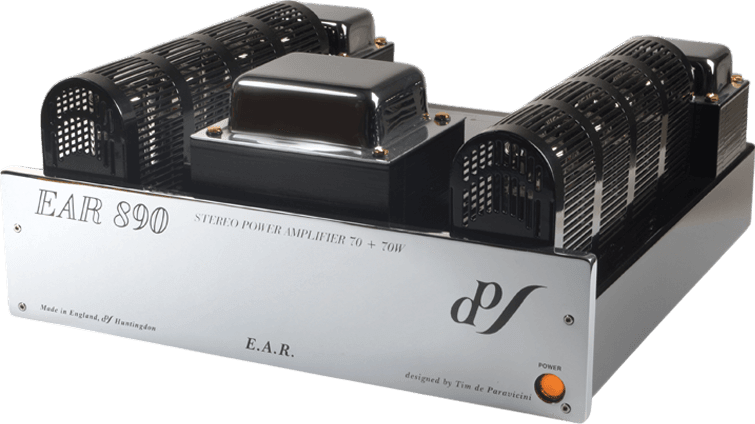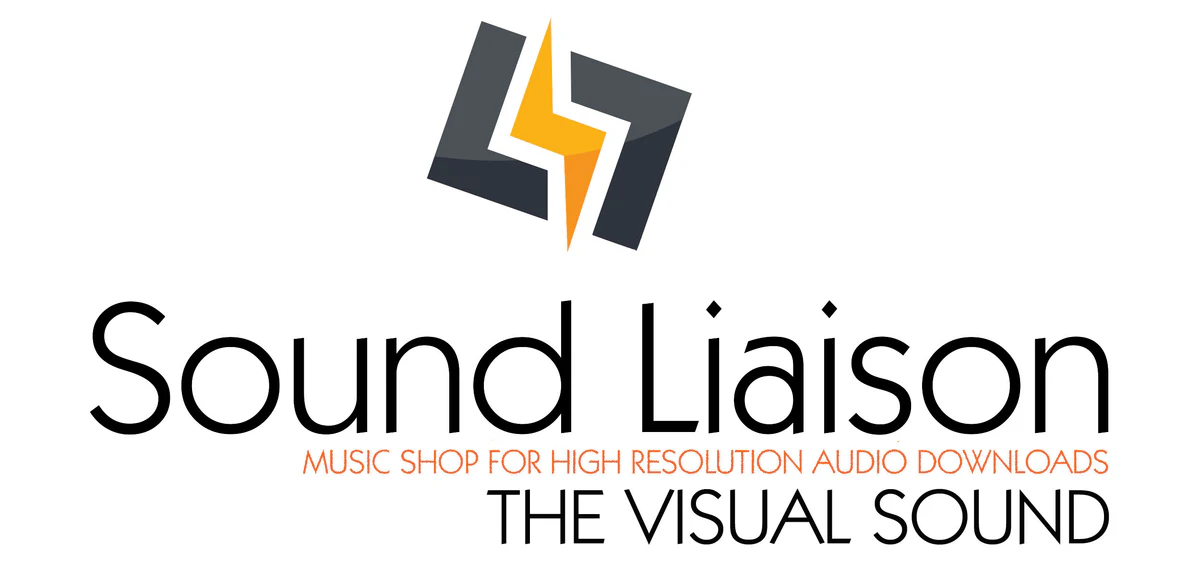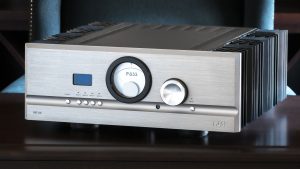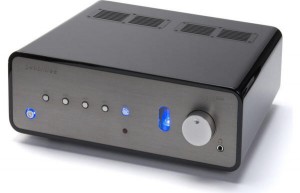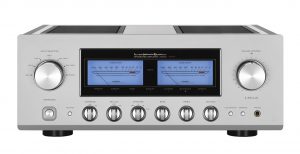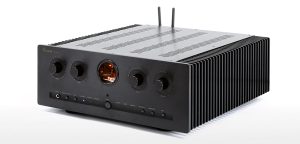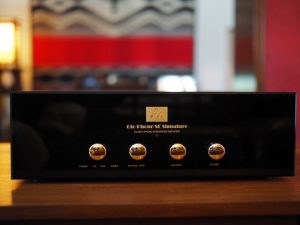This article, by Dave Clark, Larry Cox, Francisco Duran, and Roger McNichols, originally ran when audioMUSINGS was in print - Issue 4, 1998.
Let's see, a 50-watt integrated amplifier for $3600 (okay, $3595). I'd be the first to agree that this seems like a lot of money, but in all reality (audiophile "reality," that is) this is around the price point where things seem to start. Sure, there are other integrated amps at lower (some much lower) prices, but it's funny—well, actually not that funny—how, as members of the audiophile community, we need to spend quite a bit to get what we perceive to be true "high end."
Let's cut the audiophile prattle and get to the important question, "What do you get for $3600?" You get a very well made, 50-watt tube amplifier and preamplifier combined in an attractive black and chrome chassis from the true English madman, Tim de Paravicini. The fact that the preamp and amp are combined in one chassis represents a savings in space, as well as in the expense of additional interconnects, feet, and what have you. The 834, which uses relatively common parts, reflects the designer's belief that parts make little sonic difference, and that it's the execution of the circuit that matters. (This is the polar opposite of the BC3/BC3.1's design, where you'll find premium parts in a design that is as tweaked as it can get.) The E.A.R. 834 also possesses considerable heft, which is not only evident upon lifting the unit from its box, but through its portrayal of the musical message.
Using our Chario Hyper Reference 2000s to audition this unit in relation to our references, the Blue Circle BC3/BC3.1 preamp and Muse 150 monoblock amps, revealed just what kind of sound your $3600 can buy. (The Blue Circle/Muse combo will set you back roughly $7000.) In absolute terms, both were quite musical, offering us very similar presentations with slight differences. The E.A.R.'s had comparatively softer and less extended bass, slightly less overall detail and clarity, and a somewhat foreshortened soundstage, though none of this ever detracted from our enjoyment of it. Nevertheless, since it's my duty to nitpick, let me address these differences in more detail.
The BC3/BC3.1 and Muse 150 combo simply excels in delivering lifelike bass textures, extension, and slam. Our reference combo seems to go on forever, allowing the room to shake, rattle, and roll. In reproducing bass guitar, the image is of a living body placed out and into the end of the room. One can visualize the strings and body resonating and growling with texture and life, like the difference between wire-wound versus smooth nylon strings. The E.A.R.'s image is less defined and extended, creating an image of smooth strings heard from a distance, as opposed to wire-wound strings up close and personal. To be fair, we were comparing 100 solid state watts with 50 tube watts, and perhaps asking the tube amp to do something it just can't do. The E.A.R., though, was never mushy and slow, just lacking the last word in texture and extension.
On the other hand, the E.A.R. is warmer and richer through the midrange, more "tube-like" than our reference setup. The BC3/Muse combo is fast and detailed from top to bottom, reflecting their design as lean, mean amplifying machines. This quality lends itself to the music we play, allowing us to really get lost in the event. Shortly after our listening time with the E.A.R., we substituted vintage Amperex Bugle Boys for the stock Sovteks in the BC3, adding a degree of richness while sacrificing some slam and detail. This was done after an afternoon of swapping tubes and hearing how "musical" the BC3 could become with different tubes. This is not meant to be a criticism of Gilbert Yeung's choice of tubes, as the Sovteks offer the manufacturer and consumer a solid all-round performer at an affordable price. The Bugle Boys, on the other hand, are considerably more expensive ($50 versus $6 each), with a sonic character that may be valued, depending on one's system or individual taste. In our system, playing our music, the Bugle Boys took us that much closer to what we perceive as musicality. This substitution no doubt brings the performance of the two setups closer together, but in hindsight the E.A.R. is still more laid back and less revealing of source material.
The 834's treble extension is grain-free and extended, never brittle or spotlit. Cymbals and such were portrayed in a natural light. Again, details were slightly smeared or obscured compared to the reference rig, but not to a point where it detracted from the music. The amp could play loud, with enjoyable punch, dynamics, and pace, and no perceptible strain or hardening as things got busy. Yes, some congestion did set in, but hey, it is only 50 watts. Carol is more attuned to this than I am, so that's her perception. Using her favored cuts and discs, she found it harder to discern individual images within complex passages with the 834 than with our reference setup. I, on the other hand, found that cranking the volume on the 834 really got the Charios up and about. This was especially fun on tracks and discs with crunching guitars and assorted distortions and rhythms.
The biggest weakness of the 834 lies in its recreation of images within a fully fleshed-out soundstage. This may be important to you or not, but the E.A.R's portrayal of somewhat more 2d than 3D images fell behind the speakers in a not-so-deep soundstage. Width and height are very well presented, but depth is somewhat flattened compared to our reference setup. I found this not that big of a deal, but Carol wants the images as palpable as possible and way out in the room. With the E.A.R., you will find yourself listening at a greater distance, resulting in less excitement and overall dimension. This is definitely an issue of taste. It's interesting that some people will make a point of this right away, while others will hardly notice. It all boils down to what we listen for and what gets our goose a goin'.
We did enjoy our time with the 834. It offers the listener a mouthful of "high-end" sound, and for a 50-watt amp it can really kick butt. Dave Clark
Eric Shipton and Bill Tillman, two of the world's greatest mountaineers, have said that it should be possible to plan a good expedition in its entirety on the back of a cocktail napkin. In mountaineering, keeping the objective in focus supports its achievement. Yes, details are important, but it's much more important to deliver on the final objective. I doubt that either Shipton or Tillman were audiophiles, but if they owned E.A.R./Yoshino gear ("E.A.R." used to stand for Esoteric Audio Research, but the company no longer uses that name), I'm sure they'd appreciate the ability of this equipment to deliver on the big picture.
Plug in the E.A.R. 834 integrated amp, and if you love music, you will instantly have a believable reproduction of music in your room. Pick it up, and it's solid as a brick. The 834 weighs in at about 60 pounds. Controls have a solid feel. Click from tuner to CD, and there is a tactile sensation that a solid connection has been made. Connections on the back of the amp are well laid out. Visually, the 834 is striking—goldish/brassy volume and selector knobs and a shiny, polished chrome face plate. The amplifier operated without incident.
Instruments may sound a little less well-delineated with the 834 than with many other audiophile components. Although most of the detail of "audiophile" gear is present, the 834 just doesn't throw it at you, or overemphasize it. Music happens more naturally, instead of in an artificially heightened, cartoonish way. The truth is, many audiophiles perceive overemphasized detail as real. They want pinpointed instruments, and the ability to hear every polyp in a singers throat. Some, unabashedly, want detail presented like needles in their eyes. Thankfully, actual music is very infrequently delivered that way.
What I want above all else in a component is a natural tonality and timbre—that is, in part, why I bought an E.A.R. 802 preamp. If a component doesn't convey a real sense of the resonance of a voice inside a fleshy body, or the weight of a left hand on a piano, I'm just not interested in the rest of the sound. Audiophile attributes are nifty, but if the tonality isn't right, the audiophile stuff is like nice headlights on a car without wheels. The 834 presented timbre in a way that Audio Research, Conrad-Johnson or any other big name manufacturer would be proud, if not outright jealous of.
The comparison on hand is between the 834 integrated and the E.A.R. 802 preamp combined with a Classe CA 100 amplifier. The 802 is not currently available, but retailed for about $5000 when new. My reference combo therefore retails for about $6500 compared to the 834's $3600. The 802/CA 100 combination was quite similar in sound to the 834. My reference is just a bit tighter and more extended on the bottom end. It is also a little less sweet or liquid sounding, from the midrange on up to the top. I know that my system is held back by the performance of the Classe amp. I've had the Chord SPM 1200 ($5900) and the Clayton Audio S40 ($2950) in my system recently, and both amplifiers demonstrated how much more information is presented and revealed by the 802, but held back by the CA 100. That said, the 802 and the 834 are cut from the same cloth. The 802 is more finely grained than the 834, revealing information a bit more delicately. Neither is grainy sounding, but comparatively speaking, the 802 presents small details more clearly than the 834. Both are "liquid" sounding, which means that sometimes details can be "glossed over." If you are a detail hound, neither product should be on your audition list.
For instance, on "In the Colosseum" on Tom Waits' album Bone Machine, the main track is very easy to follow, but there is also background information which sounds like a CB radio was operating while the track was recorded. The background information is unintelligible on either the 802 or the 834; however, the former presents the sound more clearly, without actually sounding any louder. On other preamps, like the Blue Circle BC3, the background remains unintelligible, but is presented in a more forward fashion than either the 834 or the 802. The BC3 also presents the information as louder, which doesn't seem correct, given that the sound appears to be "environmental" rather than fundamental. In any event, either E.A.R. presentation of this recording seems more natural and "correct" than the BC3's.
On the bottom end, the 802 is a bit more extended, although neither will remind you of the tremendously taut bottom ends of the Kora Eclipse or Blue Circle BC3. Combined with more powerful amplifiers, the 802 can have a deep, really taut and fast bottom end. With my reference amplifier, the bottom end isn't terribly deep (at least with my ATCs—your mileage may vary). However, the Classe's response was a bit deeper than the 834's. I'd guess that the 834 won't present the bottom end of music as tautly as disco lovers or bass freaks will want. It should be noted that my ATCs can have pretty deep and taut bass with bigger amplifiers. My Classe just doesn't control them, and the 834 didn't either. With the Chord's 250 watts, the ATC's bottom end was very taut, and really exciting. It is unfair, therefore, to complain about the bottom end of the 834, as it was providing only 50 watts to a notoriously inefficient speaker (83 db). In other words, I wouldn't draw any conclusions about the bass performance of the 834 from this review.
In the very important midrange, the EAR 834 is hard to fault. Vocals, whether male or female, are portrayed with that natural sensation of the resonance of air inside a chest cavity. Lyle Lovett, Emmylou Harris, Jewel, and Tom Waits all gave personal performances in my listening room, or at least that's how it felt. Each singer was delivered with his or her own vocal personalities intact, whether nasal, wispy, bell-like, or gravelly. The presentation of voices was so wonderful that even if I wished for a tighter bottom end, or a more "open" top end, I forgot about that stuff and responded like my non-audiophile friends—I was just bowled over by the sound.
Acoustic instruments, from saxophone to trombone to nylon stringed guitars, were all well-rendered. In the midrange, and slightly above and below, the E.A.R. 834 is a wonder. It is a suave and subtle performer. While details may sound muted by comparison to the BC3, the 834 invited me into the musical experience, as does my 802. Musically, I'm engaged by music filled with soul, and I don't mean James Brown's kind of soul. I mean musical performances which invite you into an experience, rather than music and a sonic presentation which punches you in the nose.
Some listeners like detail up front and personal. Dave and Carol Clark are like that, which may explain their attraction to the Blue Circle BC3. That preamp, comparatively speaking, assaulted me with detail. Instead of being up front, the E.A.R. draws you in, and makes the experience more interactive than reactive. Detail is present, but requires listening into the performance. This is my cup of tea.
Imaging on the 834 exceeded my reference rig. Performers were presented with a sense of rootedness that my reference doesn't convey. Images didn't seem to waver during crescendos, or move based upon volume level. This is a nice, although not terribly important feature. In my experience, E.A.R. products don't present SHARPLY defined three-dimensional images. There is clarity and space between instruments, but listening through E.A.R. equipment, you won't get a sense that you can see the front and back of a musician playing in your room.
At $3600, the E.A.R. 834 is not cheap. Is it a good value? Maybe. If your speakers don't require lots of watts, like mine, it could be wonderful. It did compete well with my $3000-more-expensive rig. You get a lot for the money. So, who should buy one? An appropriate owner is someone that likes vocals and acoustic instruments, in which timbre is well and convincingly presented—music that requires a listener's participation to appreciate. It is not the kind of product for people who want to be goosed by their stereo, rather than drawn into the experience. Frankly, the E.A.R. 834 may be the amplifier that takes you out of the never-ending upgrade cycle, because you will have music in your home, not just hi-fi. Larry Cox
What are my partners doing to me? First it was the beautiful sounding and looking Kora equipment, and now it's the E.A.R. 834 integrated amp. All this beautiful equipment and all those glorious tubes. I admitted to myself a long time ago that music reproduced through tubes sounds more like the real (unamplified, acoustic) thing. Oh hell, even amplified! But to get that liquid midrange along with extended frequency extremes costs a lot. For that matter, great sounding solid state equipment ain't cheap either. What we have here from E.A.R. is one of their integrated models, the 834, a 50 watt amp that employs 6L6 or EL34 output tubes. Weighing in at 47 pounds, this unit is packed solid. Its class of operation is class A. This unit is very well built, and it is beautiful. For all its features and quality, at $3595 it seems to be worth every penny.
Here we go again—another very beautiful, yet highly functional unit in my system. The 834—with its chrome faceplate, two gold knobs for source selection and volume, and two rows of tubes on either side of the top of the unit, each row covered with its own black cage—looks very much like a museum showpiece, yet the speaker outputs and chrome-topped transformers tell you this integrated is ready for action. As I was unpacking the 834 from the box, my little boy walked in and said to me, "Wow, Daddy, that thing's cool!" Truth from the mouths of babes.
So cool is where I started off listening, with Miles Davis' Kind of Blue. With the 834, there's no doubt as to which is the alto and which is the tenor sax, which is Coltrane and which is Cannonball. I've heard amplifiers that made it hard to tell at certain frequencies which instruments are which. Is that a clarinet or an oboe, an alto or a tenor sax? But those kinds of problems are far removed from such a product as the E.A.R. Instrumental timbres are true to life. The E.A.R also passed the "War test" with ease. On War's two-CD boxed set of their best music, at the beginning of the song "All Day Music," the words, "yeah, yeah" are said five or six times, and as they're sung they go from stage left to stage right. On the E.A.R., the "yeah, yeah" floats effortlessly across the stage. This studio trickery is heard a lot more easily with the E.A.R than with my solid state combo. When the chorus came in with the "all day, all day" part, it filled the space between my speakers completely. Vocals come across on this amp as palpable images spread out across the stage.
While the E.A.R. 834 doesn't quite have the bass slam of my big solid state amp (no surprise there), neither does my big solid state amp have the body and dimension of instruments that this tube integrated has. Upright acoustic bass and drums sound very realistic—full, round, solid instruments with body and tone that you can hear passing out of the air holes of stringed instruments. This amp has got body in spades. Dynamics with the 834 are very well balanced. Even when playing Reggae music, like Black Uhuru, the bass was more than adequate.
Another area where I never felt deprived was the top end. Words like smooth, non-fatiguing, and effortless come to mind. While I had this amp in my system, I tried everything I had with it: TV, VCR, and CD. At first there was a hum coming through the speakers, but then I remembered it must be the video cable. Sure enough, after slapping my Mondial magic ground isolation unit on the cable box, the hum was gone. Man, the 834 sure makes watching the boob tube sweet. Come to think of it, to make this a five-channel rig, all you'd have to do is slap a Pro Logic processor with a three-channel amp, like the one I'm currently lusting after, the DPA-S50 from Vantas in Redondo Beach, which has Pro Logic, Dolby Digital, and a Discrete three-channel amplifier rolled into one, and you're set for the 90s and into the next century.
This amp sure was a great match for my ProAc speakers. I was told—no, warned—a long time ago that a tube unit was the best match for my speakers. In this case, truer words couldn't be said. Perfect amp forever? No, I don't think so. I don't think it's fair to compare the 834 to separate units that cost over twice as much. What I would like is to compare it to the Kora Design 30 or Design 50 tube integrateds, or the Classe Cap 80 or Cap 150. Now that would be more in the ball park.
As a footnote, after I had packed up the E.A.R. and hooked my usual rig back up, the sound of silence grabbed me. Boy, the background of my Classe compared to the tube unit is dead quiet. Although the 834 is a quiet-running tube amp, quieter backgrounds can be had. Seems you can't have everything!
So there you have it. Looking for an affordable full-function integrated amp that looks and sounds great? Here it is. Come to think of it, with this amp you don't need to bother with surround. Just slap on a disc, press play, close your eyes, and beautiful music will surround you. Francisco Duran
"Happiness is a butterfly which, when pursued, is always beyond our grasp, but which if you will sit down quietly, may alight upon you.
—Nathaniel Hawthorne
"A thing of beauty is a joy forever."
—John Keats
Have you been pursuing evasive "sonic butterflies," or have you been sitting quietly and letting the music alight upon you? Think about it, how much time have you spent doing both? In the midst of our hectic schedules, and the all-too-often sensory-overloaded world, what has happened to happiness, beauty, love, and many other important things, like the enjoyment of music? I have been driven to meditating on these transcendent thoughts by a new component in my audio system!
Recently I've had the wonderful privilege of spending time with the E.A.R. 834 integrated amplifier. This tube amplifier can, and will, lift your spirit to the stars. It certainly did for me. I could not have been more distracted during the reviewing period, as I was in the midst of a move. You know—packing, planning, canceling the phone, electricity, water, trash, cable, forwarding the mail, reconnecting to America Online, and a million other details. Yet, in the evening, when I was tired and sore, the E.A.R. 834 beckoned me away from the rat race and took me to the sublime.
Being Scottish, Davy Spillane's song "Midnight Walker" touches my soul. Sometimes I think it even calls up my ancestors! Davy is a uilleann piper without compare. If you don't have any of his music in your collection, run, don't walk to your nearest music store and get your hands on some. I recommend Pipedreams (Tara CD 3026), and/or the sampler CD, Celtic Graces (EMI Hemisphere). Through the 834, this lilting, charming music profoundly recharged my heart and soul.
With all my favorite CDs, the 834 excited and intoxicated me with its rich, warm sound. The separation of instruments and the swing and dance of the music came through in spades. This amplifier seems to defiantly refuse to lower itself into arguments over "solid-state accuracy" vs."tube coloration." Before you know it, you forget your critical listening skills and simply float away in the music's beauty. This was one of the 834's greatest strengths–it took me away without asking if I wanted to go!
The 834 is a Tim de Paravicini design rated at 50 watts per channel, and it uses four EL34 or 6L6 output tubes per channel. It features six inputs (Phono, CD, Tuner, Tape, A/V, Aux) and one tape output. The unit is truly gorgeous, too, with a chrome face plate and two large gold knobs for input selection and volume control. I found the build quality as impressive its look and sound.
The 834 temporarily replaced another heavyweight integrated amp, my Jeff Rowland Concentra. I could go on ad nauseum describing the wider dynamic range and quieter background of the Rowland, yet it's an obvious "apples to oranges" comparison. Rather than repeat the old arguments, I prefer to focus on what the 834 did right. What it did right was to connect me with those evasive qualities of happiness, beauty, love, musical joy, and bliss. Voices and musical instruments poured out of my Electa Amators in a relaxed, realistic, yet spectacular manner. Are tube amplifiers perfect? Of course not, but they somehow communicate to our ears and brains in a way that we can understand. When done properly, tube designs communicate to our souls in ways that we can't thoroughly explain.
It's obvious that I liked the E.A.R. 834. I'm afraid I'm raving, but if you give the 834 a listen, you'll rave, too. If you want to find happiness and musical beauty alighting on your soul (and if you don't, why are your reading audioMusings?), listen to this special amplifier. Roger McNichols, Jr.
E.A.R. 834 Integrated Amplifier
Retail $3595
E.A.R. U.S.A.
EAR Yoshino






